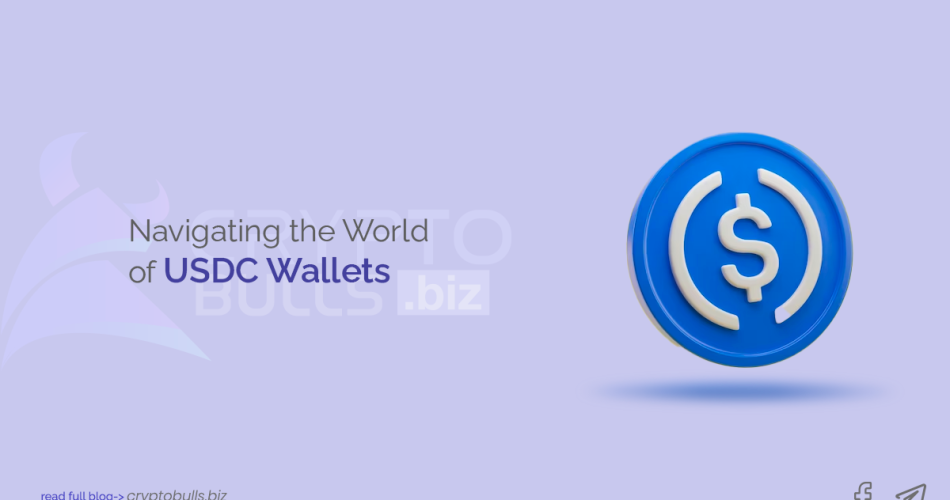Navigating the World of USDC Wallets
In the ever-changing and often turbulent world of cryptocurrencies, two fundamental attributes stand out as crucial for both newcomers and seasoned investors: stability and security. Amid the plethora of digital currencies, USDC (USD Coin) has carved a niche for itself, earning a reputation for unwavering stability and transparency. However, if you’re considering entering the realm of digital currencies, or you’re already a part of it, you may wonder how to effectively store, manage, and trade these digital dollars. This is where the USDC wallets come into play.
Understanding USDC: A Comprehensive Overview
Before diving into the intricacies of USDC wallets, it’s essential to grasp the basics of USDC itself. USDC is classified as a stablecoin, which distinguishes it from its more volatile counterparts like Bitcoin or Ethereum. What sets USDC apart is its peg to the United States dollar. For every USDC token in circulation, there is a corresponding amount of actual US dollars securely held in reserve. This foundational principle underpins USDC’s stability, making it an attractive option for those who wish to steer clear of the price volatility typically associated with other cryptocurrencies.
What is a USDC Wallet?
A USDC wallet, also referred to as a digital wallet or cryptocurrency wallet, serves as a digital tool that facilitates the storage, transmission, reception, and management of your USDC tokens. Think of it as a digital equivalent of a traditional wallet, tailored to the unique demands of the cryptocurrency realm. Let’s delve into the key components of a USDC wallet:
1. Storage: USDC wallets come in two primary categories – hot wallets and cold wallets. Hot wallets are connected to the internet, offering convenience for quick transactions. On the other hand, cold wallets are offline and provide an additional layer of security, safeguarding your assets from online threats. The choice between these two types depends on your specific requirements and priorities.
2. Security: Security is paramount in the world of cryptocurrencies, and your USDC wallet should employ robust security measures. This includes encryption to protect your data, two-factor authentication (2FA) for added login security, and biometric authentication if your device supports it.
3. Private Keys: Every USDC wallet comes with a private key, which is essentially a lengthy and intricate string of characters. This private key serves as your digital signature and must be kept confidential at all times. Sharing your private key with anyone is akin to providing them unrestricted access to your funds.
4. Public Address: Think of your wallet’s public address as its digital “username.” It’s the address you share with others when you want to receive USDC. Much like you would share your email address to receive messages, your public address is shared to receive funds.
5. User-Friendly Interface: The best USDC wallets offer a user-friendly interface that simplifies the process of navigating through your funds, sending or receiving USDC, and tracking your transaction history. A user-friendly interface is particularly beneficial, especially for newcomers to the world of cryptocurrencies.
Popular USDC Wallets
Now that you have a foundational understanding of what a USDC wallet is and its key components, let’s explore some popular options available in the market:
1. Coinbase Wallet: Coinbase is a widely recognized cryptocurrency exchange, and its wallet offering provides a secure and user-friendly experience for managing your USDC.
2. Trust Wallet: Trust Wallet is a mobile wallet known for its simplicity and robust security features. It’s an excellent choice if you prefer managing your USDC on the go.
3. Ledger Live: If your top priority is maximum security, consider using a hardware wallet like Ledger Live. This type of wallet is offline, making it resilient to online threats.
4. MetaMask: MetaMask is a browser extension wallet that seamlessly integrates with decentralized applications (dApps). This makes it an ideal choice if you are actively involved in the decentralized finance (DeFi) space.
5. Exodus: Exodus is a desktop wallet that stands out for its user-friendly interface and its built-in exchange feature. This feature makes it easy to trade USDC for other cryptocurrencies, further expanding your cryptocurrency portfolio.
How to Choose the Right USDC Wallet
When selecting a USDC wallet that best aligns with your needs and preferences, consider the following factors:
1. Security: Prioritize wallets with strong security features such as encryption, 2FA, and the option for cold storage. These elements are crucial to ensure the safety of your USDC holdings.
2. User-Friendliness: Opt for a wallet with an intuitive interface. A complicated interface can be frustrating, particularly if you’re new to cryptocurrencies.
3. Access: Think about whether you need mobile, desktop, or hardware access, depending on your lifestyle and how you plan to manage your USDC.
4. Customer Support: It’s advisable to choose a wallet with responsive customer support. In case you encounter any issues or have questions, having access to reliable customer support can be invaluable.
5. Community Reputation: Research online forums, reviews, and user feedback to gain insights into the reputation of the wallet you’re considering. Other users’ experiences can provide valuable insights into the wallet’s performance and reliability.
Storing USDC in Your Wallet
Storing USDC in your wallet is a straightforward process, and here’s a step-by-step guide:
1. Download the Wallet: Begin by selecting your preferred USDC wallet. Download and install it on your device, whether it’s a mobile device, desktop computer, or hardware wallet.
2. Create an Account: Once you’ve installed the wallet, follow the registration process to create an account. During this process, you’ll be provided with a private key. It’s of utmost importance that you securely backup this key to prevent the risk of losing access to your assets.
3. Receive USDC: To receive USDC, share your wallet’s public address with anyone who wishes to send you USDC. This is akin to providing your email address to receive funds.
4. Send USDC: When you want to send USDC to someone else, enter their public address and specify the amount you wish to send. The process is typically user-friendly within your chosen wallet.
Conclusion
In conclusion, USDC wallets serve as the gateway to securely manage your digital dollars. Whether you’re just beginning your journey into the world of cryptocurrency or you’re a seasoned investor, having a reliable and secure USDC wallet is an absolute necessity. Take your time to thoroughly research and select the wallet that best fits your unique needs and preferences. Always remember to safeguard your private keys, as they are the keys to your digital treasure chest. With the right USDC wallet, you can confidently navigate the world of digital currencies while enjoying the benefits of stability and security. Happy investing!


